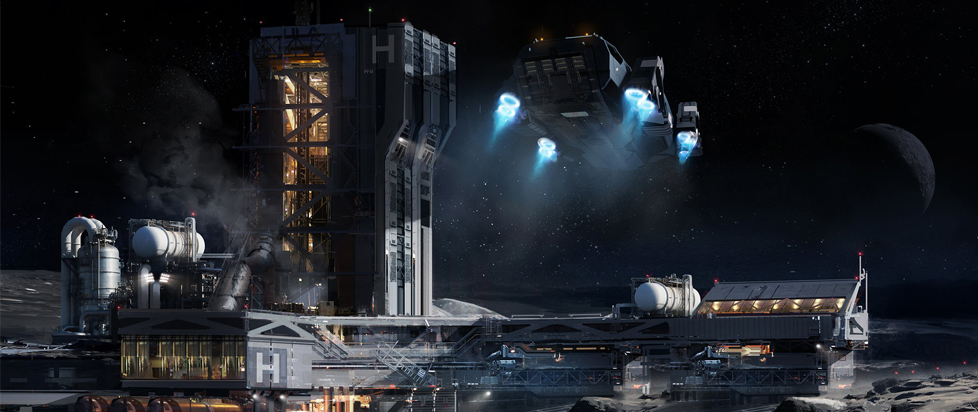
Checkpoint – Horizons
 Corey Milne stands at the intersection of gaming and world history to see what he can see.
Corey Milne stands at the intersection of gaming and world history to see what he can see.
———
This column is a reprint from Unwinnable Monthly #92. If you like what you see, grab the magazine for less than ten dollars, or subscribe and get all future magazines for half price.
———
It was greed that made me do it. Pure and simple. I had overhauled my rusting Lakon Keelback, stripping out the regular cargo holds, fighter bay and even its shield generator. A couple of million credits later and I had a makeshift ferry. A first class passenger cabin squeezed between the stark economy cubes I could pack with warm bodies. The Keelback is a cheap, short-range ship and utterly disposable. I’d received a tip that well-to-do types were paying handsomely for quick trips to and from New America’s visitor beacon. It had become the place to be. I waved goodbye to being an Imperial gunrunner and set course for the Quince system to make my fortune.
Apart from being a frighteningly powerful black hole from which my free time cannot escape, Elite: Dangerous might well be one of the best games I’ve ever played. I can easily see myself tripling the 140 hours I’ve already put into it. Mastering its systems manages to provide just as much of a thrill as the frenetic action of its laser-seared dogfighting. With nothing but the cheapest ship and a handful of credits, you’re left to make your own way in the galaxy.
The first few dozen hours you spend in Elite: Dangerous will probably be spent retreading the same ground. The ships you have access to haven’t the best of jump ranges, so the busy player-filled space becomes your home. Most players are found in the Bubble. This is inhabited space with around 20,000 systems, including our home, Sol. In this way, the game de-incentivizes exploration. There’s literally nothing new under the sun. Any scan data you hand into the Universal Cartographics corporation only nets you a couple of thousand credits if you’re lucky. It’s all about finding your space legs so to speak.
Back in the Quince system, I had run into a problem. As my reputation rose, only the richest would ride with me and they wanted to throw millions my way for a single trip. The only issue was that New America wasn’t enough for them. For 12 million credits, a researcher wanted me to take her to some star cluster, out farther than I’d ever been. Naturally, I accepted the job and, on the edge of the abyss, I took the plunge. I never made it to our destination.
[pullquote]Deep Space is one of the loneliest places I’ve ever inhabited and, if I’m completely honest, I don’t just mean in a game.[/pullquote]
Deep Space is equal parts thrilling, boring and utterly terrifying. It’s unlike anything I’d experienced in the first 100 hours of my time with Elite. I’d never felt isolation so powerfully in a game before. I’m used to having the dots of other ships light up on the dashboard display. For hundreds of light years around me, I was the only player inhabiting that space. Then, after about 50 jumps, it happened. There were no player callsigns beside any of these planets. I was the first person to inhabit this particular patch of space. That was all the incentive I needed to push forward.
The more data I collected, the more aware I became of how vulnerable I was. In my little yellow tub, that didn’t even have any shielding. The further I went, the more data I collected, so the more I had to lose. I had no idea how much any of this was worth. The fear of messing up a jump, running out of fuel and becoming stranded only grew. Roughly halfway there, which easily accounted for a dozen hours of playtime I made the decision to turn back. By the time I made it back to Quince, I had been playing for days and had made over 800 jumps.
Having played No Man’s Sky previously, another space game focused on exploration and discovery, I hadn’t considered that Elite could have such an effect on me. I think the difference being that since No Man’s Sky is such a vast, procedurally generated universe, your experience is isolated but also very personal. The chances of coming across another player’s imprint are tiny. Elite is one galaxy and you’re just another cog. It’s our galaxy though and it’s a fixed quantity, heightening the potential impact on players.
Deep Space is one of the loneliest places I’ve ever inhabited and, if I’m completely honest, I don’t just mean in a game. Every now and then, after hours of star hopping, I’d jump into a system that had another player’s tag attached to it. For a moment, two paths were crossing in an isolated pocket of the galaxy and the loneliness would melt away, replaced by a sense of camaraderie with this long gone stranger before I inevitably moved on. I think that’s the advantage Elite: Dangerous has over No Man’s Sky. Players can make an indelible mark on this vast but limited simulation. There’s a chance to be regarded. Players are able to secure their place within the histories and discoveries of this game. To definitively say, “I was here.”
When I limped back into Jefferson High spaceport, scarcely daring to breathe, it wasn’t the 26 million credits that made me cheer loud enough for the neighbors to hear. It was the pages commending me on my brand new discoveries. So that maybe one day when someone else was forging their own path through the solitude, they’d come across my name and we might share a moment together.
I haven’t sold my Keelback, the little tub that could. We’ve been through too much together and I’m already planning my next trip out. Fly dangerous, Commanders. Signing off.
Callsign: Cmdr Quantum Hawk
June, 3303 A.D.
———
Corey Milne is an Irish freelance writer who likes to poke at that strange intersection where games meet history. A roundup of his writing can be found at coreymilne.com. You can join his Rad-Lands motorcycle bandit gang on Twitter @Corey_Milne




